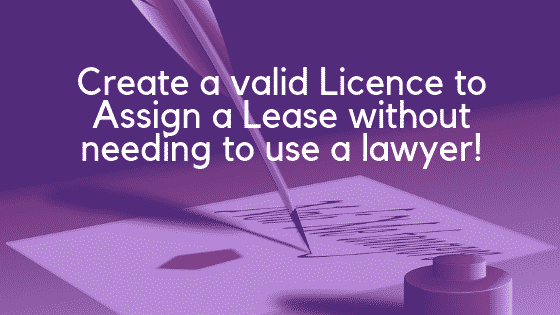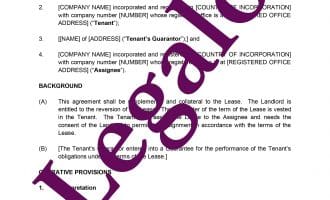Licence to Assign a Lease
Our Licence to Assign a Lease template:
- Expert-lawyer-drafted template for reliability
- Create a legally-binding licence
- Save on legal fees
- Easy to edit with our guidance notes

How Does It Work?
-
1. Download
-
2. Edit
-
3. Print
-
4. Sign
Landlord’s can use our Licence to Assign a Lease template to grant formal written permission to assign (transfer) a commercial lease from one tenant to another. Use it for commercial property that is in England or Wales, but not for Scottish property.
If you are working with residential property (long residential leases), then please use our licence to assign for residential leases.
This licence to assign incorporates various options, so it is appropriate:
- where the date of the commercial lease on or after 1 January 1996;
- whether or not there was someone guaranteeing the tenant’s obligations under the original commercial lease; and
- whether or not there is an option to renew the lease on expiry (called “security of tenure”) under the Landlord and Tenant Act 1954.
If a tenant is selling or transferring the remaining term of a commercial lease to a new tenant, it is very likely that they will need the landlord’s permission for the sale or transfer. You can simply check the terms if the lease to see if this is the case. If so, this needs the landlord to complete and sign a licence to assign.

How to assign “old”leases
You should not use this licence to assign for “old commercial leases”. An “old” lease is one where date of the lease is before 1 January 1996. There is more about this in the guide to this template. If you are looking for a licence to assign for an “old commercial lease”, then please email us at: admin@legalo.co.uk.
Other templates you may need
If you need the full batch of documents for the assignment of a lease, we offer 25% off when you buy them all at the same time using our discount package – click here for more details.
An authorised guarantee agreement (or “AGA”) does not come with this template of the licence to assign. There would normally be one in the existing lease, which you should use. If there is not, or if the present tenant does not accept its wording, then you can purchase a template AGA separately from Legalo – click on the link.
Click the link to see the full range of commercial property documents we offer.
Using the Licence to Assign a Lease template
David has drafted this template. He is our co-founder and a solicitor of over twenty years. He has written it in plain English and without legal jargon. The download comes with full guidance notes to keep completing your final document simple.
Once purchased, download the licence template in Word format and then edited to your requirements. Once the document is complete, then the parties need to sign it. Usually the landlord then passes it to the purchaser of the lease.
We provide a full money-back guarantee if you are not happy with your template document for any reason.
When you draft the licence to assign, use our free guidance notes to walk you through the document. A summary of the guidance notes can be viewed here.
What is a Licence To Assign?
The licence to assign is where the landlord and owner of the property grants permission to its tenant to sell or transfer the remaining term of the lease to another party, who will take over as the tenant.
There are situations in which a tenant will want to assign their lease. For example, a landlord owns a building which the tenant is using for storage. The tenant decides they no longer need the building. However, the original lease still has time left on it. If no “break clause” is available, to surrender the lease might cost the tenant:
- their deposit; and/or
- any rent owed to the end of the existing term of the lease.
To avoid wasting this money, the tenant has presumably asked the landlord for permission to assign (or transfer) the lease to someone who will be able to use the building and pay the rent.
What happens if the Landlord gives permission?
If the landlord agrees, the tenant would then transfer the remainder of the term of the original lease to the new tenant. This new tenant then becomes primarily responsible for paying the rent to the end of the term (although, with an AGA, the out-going tenant might still be responsible if the new tenant defaults).
The landlord will want to be sure that the new tenant is able to pay the rent before he consents to the assignment. Alternatively, he may require someone to act as a guarantor before agreeing to it.
This licence to assign is different from sub-letting. Where a sub-lease agreement is in place the existing tenant can be held responsible for any default on the original lease, even though a new tenant is in place. For a sub-letting situation you would need a sub-lease agreement and a licence to sub-let which again needs to be signed by the landlord.
Registering the Assignment of the Lease
Signing your documents is not the end of it. You may need to register the assignment at the Land Registry. For more details, click on this link and then scroll down to either:
- if your lease is unregistered, the section headed “2.3 Transfers or assignments of unregistered leases having more than seven years of the term unexpired”; or
- if your lease is already registered, the section headed “2.5 Transfers of any registered leases“.
FAQs
Below we answer some of the top questions from the Internet on Licences to Assign a Lease.
What is a licence to assign a lease in the UK?
A licence to assign a lease is a legal document by which the landlord grants a tenant of a commercial property permission to transfer the remaining term of the lease to another party. The document lays out terms and conditions for the transfer, making sure to uphold the terms of the original lease.
What is an example of a licence to assign?
This document will almost always come up in a commercial setting, for example if a commercial tenant wishes to transfer their lease to a separate business owner. Once the licence has been completed by the landlord, and all parties consent, the transfer can take place, therefore transferring the existing lease to a new tenant. It is required because almost all commercial leases state that the lease cannot be transferred unless the landlord has consented to it.
How do you assign a lease in the UK?
To start the process, a tenant needs to get (a) the landlord’s consent and (b) the landlord to sign a Licence to Assign. The current tenant will have found a new tenant and prepares the legal documents (the deed of assignment of the lease or TR1 form) with new agreed terms which the landlord must review and approve. The current tenant, the new tenant and the landlord then sign the Licence to Assign a Lease, while the old and new tenants sign the deed of assignment or TR1 form. It is likely the old tenant will also be required to sign an AGA. The new tenant will be required to sign an opt out of the right to renew the lease.
Once all the documents have been signed, if the original term of the lease was at least 7 years, then the parties register the assignment at the Land Registry using the TR1 form, so that the lease is now noted as being to the new tenant.
Do I need a licence to assign?
In the UK, almost all commercial leases require obtaining the landlord’s consent (through a Licence to Assign) before the landlord will allow a new tenant to take over the remaining term of the lease. When it comes to long residential leases, this process is rarely required, unless the lease specifically states otherwise: sometimes it is just a deed of covenant that the residential lease requires. It is always advisable to check your lease in this situation.
What is the difference between assign and licence?
In the context of property and contracts, the words “assign” and “licence” refer to different legal concepts. Assigning involves a transfer of ownership of an asset from one party to another. An assignment results in a permanent change of ownership. Licencing grants permission for someone to use someone else’s asset or rights, but they will not have transferred ownership. A licence only results in a temporary grant of rights.
Does the assignment of the lease have to be registered?
In the UK, if the original term of the lease was for 7 years or more, then you need to register the assignment of a lease with the Land Registry to establish the new tenant’s rights and responsibilities and provide clarity in the property ownership records. If you fail to report an assignment of a lease fails properly, legal complications or disputes could arise.
Who prepares the licence to assign a lease?
Typically it is down to the landlord to draft the document which details the terms of the grant of the permission to transfer the lease. Once the landlord has prepared it, both parties must negotiate the terms of the assignment before finally signing the contract. If the landlord does not want to prepare it, then the old tenant can do so.
How does a tenant request to transfer a lease?
To request a lease transfer or assignment, a tenant should:
- notify the landlord in writing of their intention to do so;
- advise of the identity of the proposed new tenant, providing their details; and
- request the necessary licence to assign to begin the process.
Is a TR1 form necessary when assigning a lease?
If the original term of the lease was for 7 years or more then you use a TR1 form in the process of assigning a lease, instead of a deed of assignment of the lease. The TR1 form is available for free from the Land Registry’s website.
Is an AP1 form necessary when assigning a lease?
You would submit an AP1 form with the TR1 form when registering the assignment of a lease that was originally for a term of 7 years or more. The reason that you need the AP1 form is because it is for an application to change the register. You submit it to the Land Registry to update the ownership information once you have all signed the assignment paperwork.
Is assigning a lease the same as selling?
Assigning a lease and selling are not the same thing for a commercial lease. This is mainly because a commercial lease requires monthly or quarterly payment of rent. So it is not an asset. Therefore you would not talk about selling the lease, as it is not an asset. When you assign a lease, it is only the rights and obligations of the tenant that you transfer. Whereas when selling a property, you transfer ownership, including land and any buildings on it. The buyer becomes the new owner and takes on all rights and responsibilities that come with the property.
However, you can “sell” a long residential lease (even though you still do this by an assignment). This is because owners see it as an asset, since they do not have to pay rent under it on an on-going basis. Instead, the first tenant paid a large premium to the landlord for the grant of the new lease. The premium represented the long-term value of the lease. So it is an asset and you can refer to it as sold.




